Athena Review Vol. 5, no. 1
Records of Life: Fossils as Original Sources
32. Jurassic and Cretaceous Britain
Jurassic cliff strata in southern England.
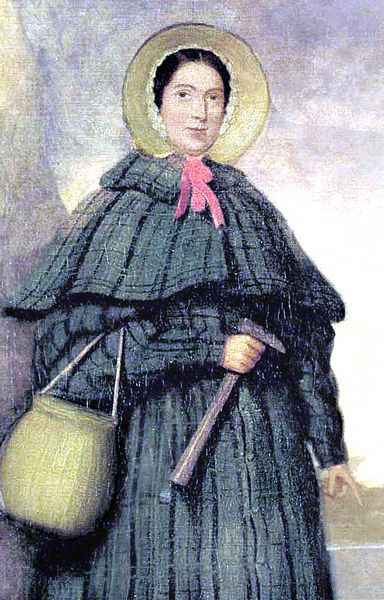 One
of the most important figures in early 19th century British
paleontology was Mary Anning (1799-1847; fig.1), who lived on the south
Devonshire coast at Lyme Regis. Starting as children, she and her
brother Joseph systematically collected the abundant Early
Jurassic fossils in the coastal cliffs between Lyme and Charmouth.
These cliffs, part of the
Blue Lias formation, consist of alternating layers of limestone and
soft shale or claystone, deposited during the Late Triassic and Early
Jurassic periods (200-195 mya). Individual strata were known to Mary
and Joseph Anning as the likely find spots of fossils types only known
from that layer (the same principle of stratigraphy first described in
the 17th century by Nicholas Steno, and later by William
"Strata" Smith).
One
of the most important figures in early 19th century British
paleontology was Mary Anning (1799-1847; fig.1), who lived on the south
Devonshire coast at Lyme Regis. Starting as children, she and her
brother Joseph systematically collected the abundant Early
Jurassic fossils in the coastal cliffs between Lyme and Charmouth.
These cliffs, part of the
Blue Lias formation, consist of alternating layers of limestone and
soft shale or claystone, deposited during the Late Triassic and Early
Jurassic periods (200-195 mya). Individual strata were known to Mary
and Joseph Anning as the likely find spots of fossils types only known
from that layer (the same principle of stratigraphy first described in
the 17th century by Nicholas Steno, and later by William
"Strata" Smith). Fig.1: Portrait of Mary Anning .
Among the most common fossil finds in these early Jurassic layers are ammonites and belemnites. Ammonites are coiled cephalopods with a series of whorl-shape chambers (fig.2). More closely related to the current squid and octupus than to the nautilus, they were named for the "horns of Ammon" (the Egyptian god Amun) by t
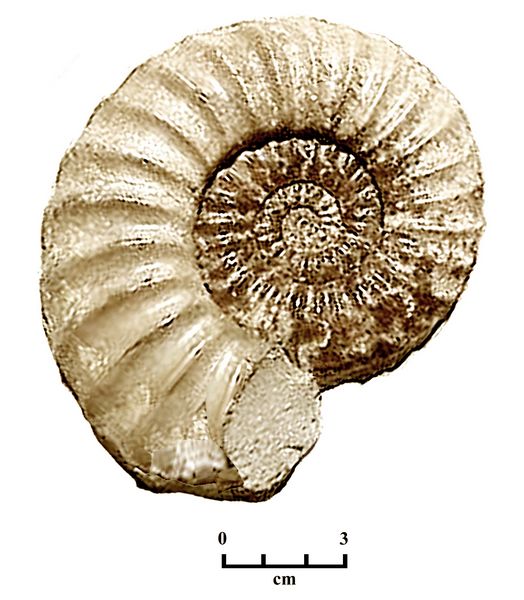 he Roman geographer Pliny
the
Elder.
he Roman geographer Pliny
the
Elder.
Fig.2: Lower Jurassic ammonite Asteroceras obtusum, Lower Lias Formation, Lyme Regis
Belemnites (fig.3), whose pointed, rodlike "guard" is one of the most commonly found fossils in the Jurassic deposits around the English Channel, are another type of extinct, squid-like cephalopod. The guard formed a kind of forward armor attached to the belemnite's many-chambered, cone-shaped midsection, called a phragmacone. As the animal grew, it moved forward in the body chamber and secreted a septum, which became the series of chambers called the phragmocone (Owen 1844; Mantell 1848). Behind this trailed multiple arms, as seen on modern squids when swimming.

Belemnites are sometimes wonderfully preserved, especially in strata such as the Late Jurassic Oxford Clay found at Christian Malford at Wiltshire (Mantell 1848). In 1826, Mary Anning discovered fossilized ink chambers of belemnites at Lyme Regis. Together with her brother Joeph and a friend, Elizabeth Philpot, she was reportedly able to retrieve some of the carbonized ink; whereafter, she and a friend, Sir Henry Thomas De la Beche, are said to have used some of the ink to make drawings of ichthyosaur and pterosaur fossils (Pharaoh 1837).
Large marine vertebrate fossils such as plesiosaurs and ichthyosaurs were also present at Lyme Regis, but much rarer. These were highly desirable specimens that Mary and Joseph Anning, and their parents, also skilled fossil collectors, could sell to collectors, and thereby make a living. Their customers included Adam Sedgwick, who used specimens he obtained from Mary Anning in his geology courses at Cambridge University.
Fig.3: Jurassic belemnite Belemnites attenuatis (Mantell 1848, pl.15c, drawn by Joseph Dinkell).
Some of the most important finds from Lyme Regis were skeletons of large Jurassic sea reptiles, some of species never before described. In 1811, when Mary was 12, her brother Joseph dug up a 4-foot skull of Ichthyosaurus platydon. A few months later, Mary found the rest of the skeleton. The find was published in 1814 by Everard Home, a surgeon and anatomist who was the first to formally describe it.
Her next major discovery in 1820 was a partial skeleton (lacking the skull) of a Plesiosaur, another large sea reptile who flourished during the Jurassic period. This fossil, named Plesiosaurus dolichodeirus ("near lizard with a long neck"), is the type specimen (holotype) of the species, although it is not the first described fossil of the order Plesiosauria. That distinction goes to a partial skeleton drawn by William Stukely in 1719, on a stone slab from a quarry at Fulbeck. It had been displayed in the local vicarage as the remains of a sinner drowned in the Great Flood. Stukely, when informed of it by Robert Darwin of Elston (great-grandfather of Charles Darwin), recognized it was a sea creature, possibly a crocodilian. Today it resides in the British Museum of Natural History as specimen BMNH R.1330.
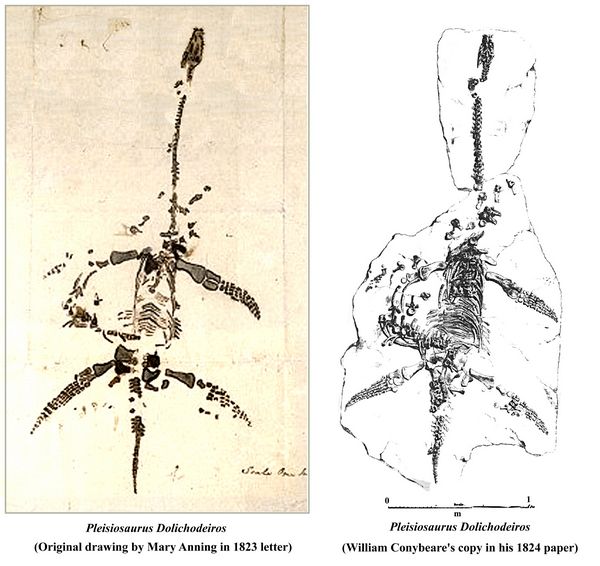 The more complete skeleton of . dolichodeirus
found in 1820 by Mary Anning was soon thereafter described by William
Conybeare, in a 1821 paper he co-authored with Henry De la Beche on
ichthyosaur anatomy. The paper, however, made no mention of Mary Anning
having found the fossil, despite the fact that she was a friend of the
co-author Beche. This kind of omission seems to have occurred fairly
frequently, as indicated below.
The more complete skeleton of . dolichodeirus
found in 1820 by Mary Anning was soon thereafter described by William
Conybeare, in a 1821 paper he co-authored with Henry De la Beche on
ichthyosaur anatomy. The paper, however, made no mention of Mary Anning
having found the fossil, despite the fact that she was a friend of the
co-author Beche. This kind of omission seems to have occurred fairly
frequently, as indicated below. Fig.4: (left:) Original drawing of Plesiosaurus dolichodeiros by Mary Anning (1823). (right:) Copy by William Conybeare (1824).
In 1823 Mary Anning discovered another, more complete plesiosaur skeleton and skull of the same species, which she described in a letter containing an accurate drawing of the fossil (fig.4, left). The skeleton was bought by the Duke of Buckingham, who lent it to the geologist William Buckland. Buckland let Conybeare describe the fossil on February 24, 1824 in a lecture to the Geological Society of London. Conybeare, who named it Plesiosaurus dolichodeirus, made a copy of Mary Anning's drawing of the fossil skeleton (fig.4, right), but failed to credit or name her as its discoverer. He did however, also present several other, largely accurate drawings made by himself of the Plesiosaur skeleton, including details of the shoulder and pelvic girdles, limbs, and digits, showing he had gained a good understanding of Plesiosaur anatomy (Conybeare 1824). In 1848, the British Museum of Natural History bought the skeleton, now catalogued as BMNH 22656.
Mary Anning (somewhat like William Smith in this regard) was not part of the high social or academic strata of England, and also like him, her work was often used by others without giving her sufficient credit. Anning, nevertheless, was acquainted with, and well respected by, many of the most important geologists and paleontologists of her time. One of Anning's early friends was Henry de la Beche, who also grew up in Lyme Regis, and in 1835 became the first director of the Geological Survey in England. The Swiss paleontologist Louis Agassiz, who visited Lyme Regis in 1834, worked with Anning and her friend Elizabeth Philpot to study fish fossils from the region. In his Studies of Fossil Fish (1833-1843), Agassiz named two fish species after Anning, Acrodus anniangiae, a cartilaginous fish from the Triassic, and Belenostomus anningiae; and another after Philpot. When Roderick Murchison did early field work in Lyme, his wife, Charlotte, also worked with Mary Anning to study fossil collecting. The two women became lifelong friends and correspondents. Anning was also consulted by Charles Lyell for information used in his 1833 geology textbook, regarding how the sea was eroding the coastal cliffs around Lyme.
Overall, the fossils discovered and collected by Mary Anning, and other members of her family at Lyme Regis, provided significant evidence for the paleontology of the extensive Early Jurassic strata around the English Channel, exposed in both southern England and Normandy, France.
British dinosaurs and belemnites
During the same Feb. 24, 1824 meeting of the Geological Society of London where Conybeare described the Plesiosaur discovered by Mary Anning, another new fossil, a carnivorous reptile named Megalosaurus, was presented by the geologist William Buckland (1824), representing the first valid genus of dinosaur to be named. The type species, Megalosaurus bucklandii, was established in 1827. Later, Megalosaurus was one of three genera on which Richard Owen based his identification of Mesozoic land reptiles, which he named Dinosauria, or "Terrible lizards." Owen published the first important account of dinosaurs in 1842. The other two founding members of the initial dinosaur grouping were the herbivorous Iguanodon, and the armoured Hylaeosaurus, both discovered by the geologist Gideon Mantell. Owen, however, in a move not entirely to his credit, cited himself and Georges Cuvier as the discoverers of the Iguanodon, thereby excluding any credit for Mantell (Owen 1842).
 The
genus Iguanodon ("iguana tooth") is currently identified within the
larger group Iguanodontia, along with the duck-billed hadrosaurs.
Iguanadon, the type species (fig.5), was a large plant-eating dinosaur,
widespread in Asia, North America, and Europe during a two million-year
interval at the end of the Jurassic and start of the Cretaceous periods
(126-124 mya). While in the past the genus has had many local species
attributed to it, it is now thought to comprise only a single
species, Iguanodon bernissotensis, named for a site in Belgium where
many well-preserved specimens were found starting in the 1880s.
The
genus Iguanodon ("iguana tooth") is currently identified within the
larger group Iguanodontia, along with the duck-billed hadrosaurs.
Iguanadon, the type species (fig.5), was a large plant-eating dinosaur,
widespread in Asia, North America, and Europe during a two million-year
interval at the end of the Jurassic and start of the Cretaceous periods
(126-124 mya). While in the past the genus has had many local species
attributed to it, it is now thought to comprise only a single
species, Iguanodon bernissotensis, named for a site in Belgium where
many well-preserved specimens were found starting in the 1880s. Fig.5: Skeleton of Iguanodon.
Gideon Mantell (1790 -1852), a doctor, geologist, and palaeontologist who had worked on Cretaceous strata in
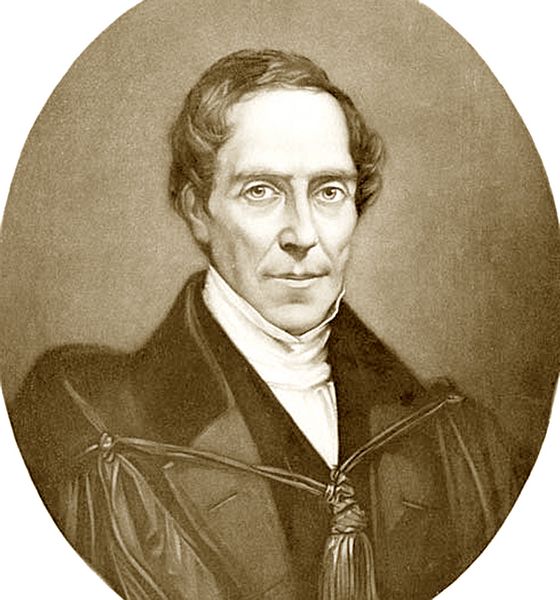 southern England, in 1822
discovered the first fossil Iguanodon teeth, and eventually found much
of its skeleton. Mantell (1825) originally identified that the
teeth of Iguanodon were similar to those of a herbivorous reptile such
as the Iguana (hence the genus name he selected). It also had other
features unlike any modern reptile, such as a toothless, scoop-shaped
symphesis or tooth vacancy of the lower jaw, which Mantell saw as a
functional analogy with modern herbivores such as the giraffe.
The Iguanodon skull was long and narrow, with a projecting keratin beak
(fig.7). The upper jaw held up to 29 chisel-like teeth per side,
lacking any at the front of the jaw; while the lower jaw had 25 teeth
meeting the upper teeth, but broader. Because the reptilian teeth were
continually replaced, Iguanodon could eat tough plant material such as
tree leaves and grasses.
southern England, in 1822
discovered the first fossil Iguanodon teeth, and eventually found much
of its skeleton. Mantell (1825) originally identified that the
teeth of Iguanodon were similar to those of a herbivorous reptile such
as the Iguana (hence the genus name he selected). It also had other
features unlike any modern reptile, such as a toothless, scoop-shaped
symphesis or tooth vacancy of the lower jaw, which Mantell saw as a
functional analogy with modern herbivores such as the giraffe.
The Iguanodon skull was long and narrow, with a projecting keratin beak
(fig.7). The upper jaw held up to 29 chisel-like teeth per side,
lacking any at the front of the jaw; while the lower jaw had 25 teeth
meeting the upper teeth, but broader. Because the reptilian teeth were
continually replaced, Iguanodon could eat tough plant material such as
tree leaves and grasses. Fig.6: Portrait of Gideon Mantell
Eventually, Mantell acquired enough skeletal evidence to show that Iguanodon's forelimbs were much shorter than its hindlimbs, and that it might have been partly bipedal, an essential trait in terms of both foraging and moving about. Owen, however, had believed it to have been a stumpy, mammal-like creature with four thick legs, and so reconstructed Iguanodon at the British Museum. Mantell's findings of Iguanadon leg bones served to refute Owen's belief. Mantell also demonstrated that fossil vertebrae, which Owen had attributed to a variety of different species, all belonged to Iguanodon.
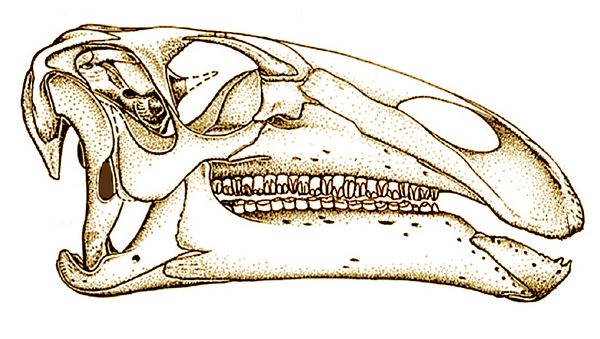 With the 1880s discovery of complete Iguanodon skeletons at Bernissart,
Mantell's view was fully vindicated, as its semi-bipedal nature was
verified. Iguanodon rested and walked mainly on its four legs, but
could stand up to forage for food. With a body length of about 10
meters, it was up to 4-5 meters high, and could eat eat food ranging
from ground plants to tree foliage.
With the 1880s discovery of complete Iguanodon skeletons at Bernissart,
Mantell's view was fully vindicated, as its semi-bipedal nature was
verified. Iguanodon rested and walked mainly on its four legs, but
could stand up to forage for food. With a body length of about 10
meters, it was up to 4-5 meters high, and could eat eat food ranging
from ground plants to tree foliage. Fig.7: Skull of Iguanodon bernissotensis.
The digits of Iguanodon's feet and hands were specialized. Iguanadon belongs to a major dinosaur group called ornithopods, "bird feet," as distinguished from another major group, the sauropods, or "lizard feet." The Iguanodon foot (pes) had three elongated digits with claws; its hand (manus), meanwhile, retained the primitive tetrapod trait of 5 digits, but with specializations. The three central fingers were strong and capable of bearing the body's weight, while the first and fith fingers were specialized. Long, prehensile fifth fingers were probably used to probe for food, while large thumb spikes were suitable for defence against predators. The thumb spike, one of the best known features of Iguanodon, was conjecturally (and incorrectly) placed on the animal's nose by Mantell, who simply lacked sufficient fossil evidence of the digits. Much more complete specimens found at Bernissart showed it belonged on the hand, as a modified thumb (Bollo).
Mantell, meanwhile, also discovered and named Hylaeosaurus ("forest lizard"), the third genus which Owen (1842) included in his initial group of dinosaurs. Hylaeosaurus was an armored (ankylosaurian) dinosaur about five meters long, who lived during the Early Cretaceous, Valinginian stage (136-137 mya). The type species named Hylaeosaurus armatus was an herbivore, with protective armor plates, and at least three long spines on its shoulder and shorter spines at the side of its neck.
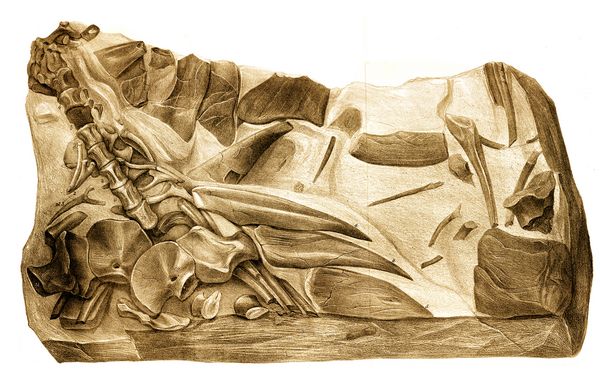 Its fossils were first discovered in 1832 in Tilgate Forest in West
Sussex, where a quarry face revealed about 50 bones of a saurian
(fig.8). The geological context was within the Early Cretaceous
Grinstead Clay Formation , part of the Wealdon Formation dated at about
137 mya.
Its fossils were first discovered in 1832 in Tilgate Forest in West
Sussex, where a quarry face revealed about 50 bones of a saurian
(fig.8). The geological context was within the Early Cretaceous
Grinstead Clay Formation , part of the Wealdon Formation dated at about
137 mya. Fig.8: Hylaeosaurus armatus fossil in its limestone matrix, from Tilgate, Sussex. In the British Museum. ( J. Erxleben 1858)
Mantell bought the fossil fragments from a local dealer, then was able to reconstruct them as a partial skeleton. The assembled fossils, now comprising the holotype of Hylaeosaurus, included the rear of the skull and portions of the lower jaw, ten vertebrae, both scapulae, both coracoids and several spikes and armour plates. This represented the most complete dinosaur skeleton known at that time, and the first described armored dinosaur or ankylosaurian. Upon seeing the fossils, William Clift, curator of the Royal College of Surgeons museum, identified the plates and spikes as part of body armor, leading to the naming of the type species as Hylaeosaurus armatus ("armored forest lizard").
On December 5, 1832 Mantell reported the find of Hylaeosaurus to the Geological Society of London. On the advice of his friend Charles Lyell, Mantell decided to publish a book on his fossil finds with a chapter on Hylaeosaurus. The book, completed in three weeks and published in May 1833 as The Geology of the South-East of England, named the type species as Hylaeosaurus armatus, currently considered the only valid species in the genus. The original specimen of Gideon Mantell was later acquired by the Natural History Museum of London (cat. NHMUK 3775; fig 8).
The classification of both dinosaurs discovered by Mantell, Hylaeosaurus and Iguanodon, continue to be much debated, as long-standing species are gradually reassigned to other genera, in the constant reorganization of taxa using cladistic methods. In a process which seems to contradict the rule of priority in the naming of taxa (cf. Benton 2000), Mantell's original 1825 identification of the genus Iguanodon is now considered to have been based on specimens currently assigned to different genera and species of Iguanodontia. Mantell was never very fortunate, it seems, with regards to receiving full credit for his discovery. As noted above, Owen, in his 1842 paper introducing the Dinosauria, actually credited himself and Georges Cuvier with Iguanodon's discovery, while excluding any credit
 for
Mantell, who had worked for years accumulating fossils in order
to establish the new genus.
for
Mantell, who had worked for years accumulating fossils in order
to establish the new genus. Owen, in spite of his expertise and many accomplishments, had certain ways of making enemies. He was subject to (apparently, well-founded) accusations that he sometimes failed to give credit to the work of others. In 1846, after he was awarded the Royal Medal for an 1844 paper he had written on unusual belemnite fossils, it was discovered that Owen had failed to acknowledge that the specimens actually had been discovered and previously reported by an amateur biologist, Joseph Chaning Pearce (a fact that Mantell helped bring to light). For this, Owen would eventually be dismissed from both the council of the Zoological Society and the prestigious Royal Society.
Fig.9: Portrait of Richard Owen
Channing Pearce had discovered the fossils in 1842 in a section of the Oxford Clay formation at Chistian Malford in Wiltshire, exposed by construction of the Great Western Railway. These fossils were unusual in that, while very well preserved, they lacked the hard, rod-shaped rostra or guards typical of the genus Belemites, which are frequently the only part preserved. Since these were missing, Channing Pierce proposed these belemnites had rostra made of thin sheaths that were not preserved as fossils, and thus constituted a newly discovered genus. The same year, he described Belemnotheutis as such to the Geological Society of London.
Another paleontologist, Samuel Pratt, meanwhile had found other well-preserved specimens of Belemnotheutis at the same site, which he gave to Richard Owen. In 1844, when Owen published his paper describing the fossils, he named the species Belemnites owenii Pratt, after himself and Pratt, meanwhile failing to mention Channing Pierce (Owen 1844). Owen proposed the specimens had simply lost their rostra, and were part of the original genus Belemnites.
When Owen received a Royal Medal from the Royal Society in 1846 for the 1844 paper, Channing Pearce wrote in response a paper, published in the London Geological Journal in 1847, protesting that Owen's descriptions of the specimens were inaccurate, and that he had deliberately failed to credit Channing Pearce with the discovery of Belemnotheutis, showing little respect for the opinions of less well-known paleontologists. Although Channing Pearce died later in the same year, his opinions received substantial support from Gideon Mantell, who in 1848 described newly found Belemnotheutis specimens (fig.10), which demonstrated that the differences between Belemnites and Belemnotheutis were enough to justify their being distinct genera. Among these distinguishing features was a groove on the back surface of the Belemnotheutis which Owen had attributed as artifacts of crushing. Owen, who was present when Mantell read his paper, ridiculed it rather than accepting the new information.
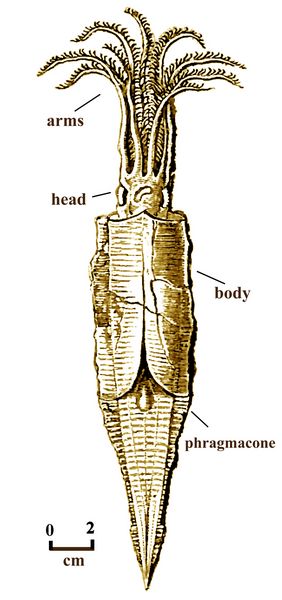 Fig.10: The belemnite Belemnothereutus antiquas, from Mantell's book The Geology of South-east of England (1851).
Fig.10: The belemnite Belemnothereutus antiquas, from Mantell's book The Geology of South-east of England (1851).This rivalry continued until Mantell's death in 1852, with Owen even opposing the awarding of the Royal Medal to Mantell in 1849 for his work on Iguanodon, an award which he eventually received. As already noted, Owen had also in 1842 attempted to claim credit for discovering Iguanadon. Mantell 's (and Channing Pierce's) views on Belemnotheutis. meawhile, continued to be supported by other geologists and paleontologists including Charles Lyell. New descriptions were made, for example, on a similar cephalopod named Acanthoteuthis, which also had a thin-walled rostra, and for which Belemnotheutis was considered as a synonym genus name. Finally, in 1860, several years after Mantell had died, Owen published an acknowledment that Belemnotheutus was indeed a distinct genus based on its very thin rostra, which was rarely if ever preserved in the fossil record, as well as other anatomical differences.
Owen (1804-1892) was otherwise a most accomplished paleontologist. He studied medicine and specialized in comparative anatomy. In 1854 he became superintendant of natural history collections at the British Museum, a post he held until 1881when the Natural History Museum in South Kensington, London was opened, which he had helped establish. Among many pubications, Owen's three volume Comparative Anatomy and Physiology of Vertebrates (1866–1868) was the most comprehensive treatment since Cuvier's Leçons d'anatomie comparée. Owen's writings on British reptiles were reprinted in his History of British Fossil Reptiles (4 vols. London 1849–1884), which provided comparative data for his 1876 (also published by the British Museum). Owen's original research on rare or extinct birds in 1840–1846 included papers on the kiwi, the dodo, the Great Auk, and the extinct Dinornithidae of New Zealand. Also notable was his 1863 monograph on the famous Jurassic fossil Archaeopteryx, a reptilian toothed bird found in Bavaria which, in January 1863, Owen bought for the British Museum. While Owen described it unequivocally as a bird, it also fulfilled Darwin's prediction that a proto-bird with unfused wing fingers would be found,
Based on fossil remains of hoofed mammals or ungulates, Owen in 1848 was the first to identify the two main groups of odd-toed (Perissodactyla) and even-toed (Artiodactyla) ungulates. Owen recognized and named several large ungulate taxa from South America, including the rhino-like Megatherium from the Oligocene, 32-20 mya (1860). He also named
Based on specimens from the Karoo Basin in South Africa, Owen was also the first to recognize and describe one of the major branches of the Therapsids or mammal-like reptiles, the Anomodontia ("undefined teeth"). In 1845, he described Dicynodon ("two dog teeth"), a major taxon of the Anomodontia, and the type species for the Dicynodonts, one of two branches of Therapsids to survive the end-of-Permian mass extinction. The other branch was Cynodonts ("dog teeth"), the direct ancestors of mammals. Owen also helped define the lungish (Dipnoi), an order of the sarcoptyerians, or lobe-fin fish, some of whom were ancestors of tetrapods. His memoir on the African lungfish, which he named Protopterus, laid the foundations for the recognition of the Dipnoi by Johannes Müller.
Owen vs. Darwin and Huxley.
After Darwin's return from the Beagle voyage, on October 29, 1836 he was introduced by Charles Lyell to Owen, who agreed to identify fossil bones collected in South America. Owen's subsequent findings on Toxodon, Glyptodon (1839), a giant armadillo, and the giant ground sloth Mylodon (1842), both dating from the glacial era of the Pleistocene, showed that they were large varieties of rodents and sloths. This indicated they were related to current species in South America, rather than being ancestors of similarly sized creatures in Africa, as Darwin had originally thought. This was one of the many influences that led Darwin later to formulate his own ideas on the concept of natural selection.
During the development of Darwin's theory, his investigation of barnacles showed, in 1849, how their segmentation related to other crustaceans, showing how they had diverged from their relatives. To both Darwin and Owen such "homologies" in comparative anatomy was evidence of descent. Owen demonstrated fossil evidence of an evolutionary sequence of horses, as supporting his idea of development from archetypes in "ordained continuous becoming.
Owen eventually, however, became an antagonist of both Darwin and his chief supporter, Thomas Henry Huxley. In his role as President-elect of the Royal Association, Owen presented his own authoritative anatomical studies of primate brains, claiming that the human brain had structures that apes brains did not, and that therefore humans were a separate sub-class.. Owen's main argument was that humans have much larger brains for their body size than other mammals including the great apes.
This initiated a long-standing feud between Owen vs. Darwin and Huxley. Darwin wrote that "I cannot swallow Man [being that] distinct from a Chimpanzee". Thomas Henry Huxley used his March 1858 Royal Institution lecture to deny Owen's claim, and affirmed that in terms of anatomy, gorillas are as close to humans as they are to baboons. He believed that the "mental and moral faculties are essentially... the same kind in animals & ourselves".
On the publication of Darwin's theory On The Origin of Species, he sent a complimentary copy to Owen, saying "it will seem 'an abomination'". Owen was the first to respond, claiming that he had long believed that "existing influences" were responsible for the "ordained" birth of species. Darwin then spoke further with Owen, who at that point said that On the Origin of Species offered the best explanation "ever published of the manner of formation of species."
In April 1860, however, Owen published an anoymous review of On the Origin of Species in the Edinburgh Review, where he criticized what he saw as Darwin's caricature of his own axiom of "the continuous operation of the ordained becoming of living things". Afterwards, Owen's views were criticized repeatedly by Huxley and, less vocally, by Darwin.
References:
Agassiz, L. 1833-1843. Recherches sur les poissons fossiles [Researches on Fossil Fish], 5 vol. Neuchatel, Petitpierre.1833-1843
Anning, M. 1823. Letter describing the discovery of a fossilized Plesiosaur skeleton. Lyme Regis, England.
Buckland, L. 1824. Transactions of the Geological Society of London.
Carpenter, K., 2001, "Skull of the polacanthid ankylosaur Hylaeosaurus armatus Mantell, 1833, from the Lower Cretaceous of England." In Carpenter, K. (ed.). The armored dinosaurs. Indiana University Press, Bloomington and Indianapolis, pp 169–172.
Conybeare, W. 1824. Transactions of the Geological Society of London.
Cuvier Leçons d'anatomie comparée.
Darwin, C. 1839, Voyages of the Adventure and Beagle, Volume III, Journal and remarks ,1832–1836 (ed. Fitzroy, R.). London, Henry Colburn.
Darwin, C. 1859. On the Origin of Species, by Means of Natural Selection. London, John Murray.
Lyell, C. 1833. Elements of Geology
Mantell, G.A. 1833. The Geology of the South-East of England. Longman Ltd., London
Mantell, G.A., 1841, "Memoir on a portion of the lower jaw of the Iguanodon and on the remains of the Hylaeosaurus and other saurians, discovered in the strata of Tilgate Forest, in Sussex", Philosophical Transactions of the Royal Society of London, 131: 131–151
Murchison, R.I., 1835. “On the Silurian System of Rocks.” London and Edinburgh Philosophical Magazine and Journal of Science, vol. 7, pp. 46-52.
Murchison, R.I., 1839. The Silurian System, founded on geological researches in the counties of Salop, Hereford, Radnor, Montgomery, Caermarthen, Brecon, Pembroke, Monmouth, Gloucester, Worcester, and Stafford; with descriptions of the coal-fields and overlying formations. (2 vols.) John Murray, London.
Murchison, R. I., and A. Sedgwick 1835. "On the Silurian and Cambrian Systems." Report of the meeting of the British Association for the Advancement of Science, pp. 59–61.
Owen, R.1842
Owen, R. 1844
Owen, R. 1849-1884. History of British Fossil Reptiles (4 vols.) London. British Museum.
Owen, R. 1866-1868. Comparative Anatomy and Physiology of Vertebrates. London, British Museum.
Owen, R. 1876. Catalogue of the Fossil Reptilia of South Africa. London, British Museum.
Pharaoh, J.B. 1837. "Fossil Remains of naked Mollusks, Pens, and Ink-Bags of Loligo". Madras journal of literature and science. Madras Literary Society, Auxiliary Royal Asiatic Society, 5 (14), pp. 403–406.
Sedgwick, A., 1833. “The geology of Caernarvonshire.” Report of the first and second meetings of the British Association for the Advancement of Science; at York in 1831,and at Oxford in 1832, (Geology Section), vol. 1833, pp. 591-592.
Sedgwick, A., 1852. “On the classification and nomenclature of the Lower Palaeozoic rocks of England and Wales.” Quarterly Journal of the Geological Society of London, vol. 8, pp.136-168.
Sedgwick, A. and F. M'Coy 1855. A synopsis of the classification of British Palaeozoic rocks, with a systematic description of the British Palaeozoic fossils in the Geological Museum of the University of Cambridge. (2 vols.) J.W. Parker, London.
Sedgwick, A. and R.I. Murchison 1835. “On the Silurian and Cambrian Systems, exhibiting the order in which the older Sedimentary Strata succeed each other in England and Wales.” The London and Edinburgh Philosophical Magazine and Journal of Science, vol. 7, pp. 483-485.
Smith, William 1815. Geological Map of England and Wales.
Smith, William 1816.
Steno, Nicholas 1667. Nicolai Stenonis Elementorum Myologiae Specimen, seu Musculi Descriptio Geometrica, cui accedunt canis carchariae dissectum caput et dissectus piscis ex canum genere... Florentiae : ex typ. sub signo Stellae, via Bibliothèque interuniversitaire de médecine, Paris.
Wikipedia 2014a, "Mary Anning"
Wikipedia 2014b, "Richard Owen."
Wikipedia 2014c, "Gideon Mantell."
Glossary